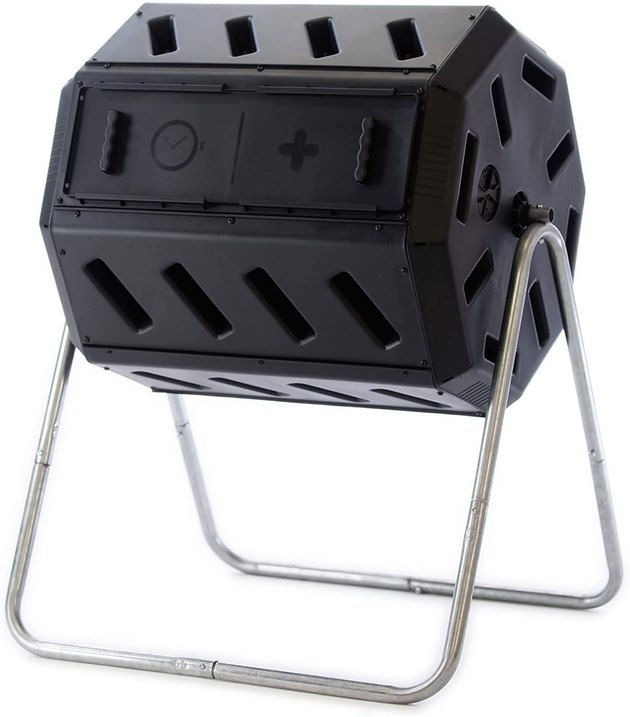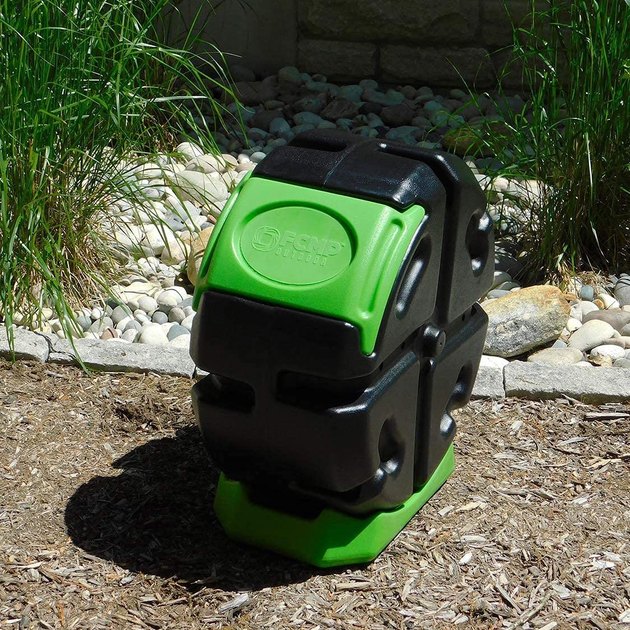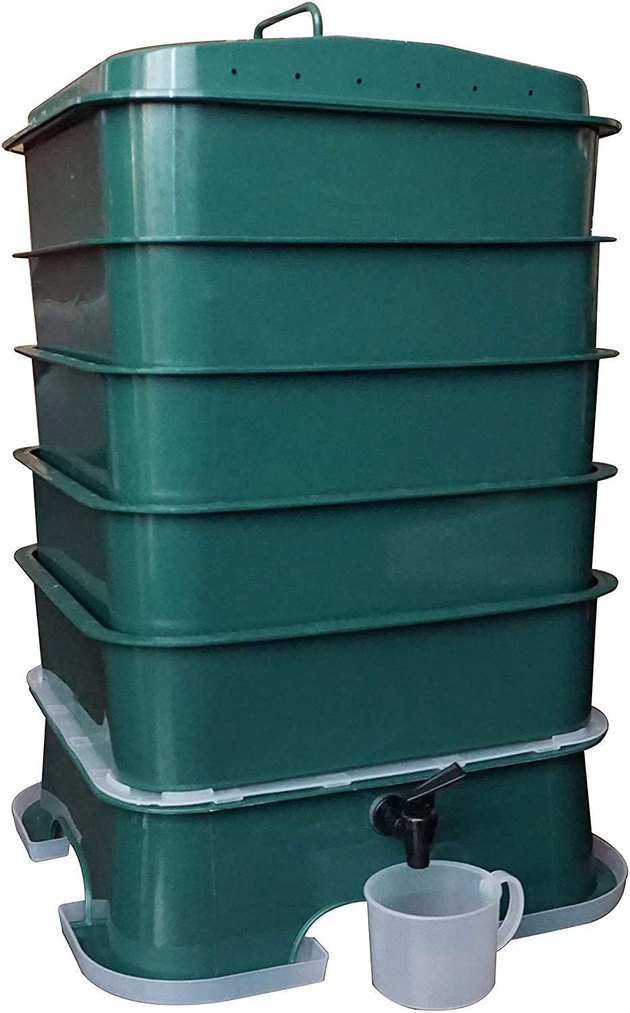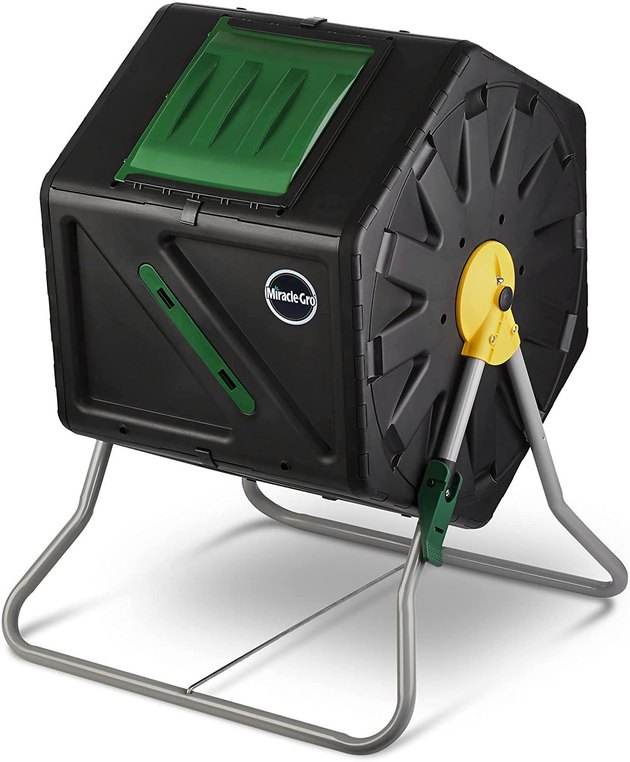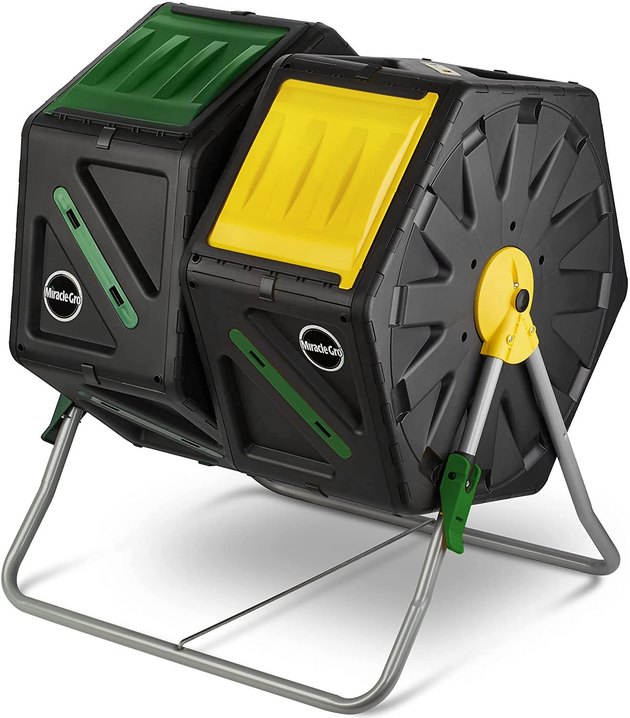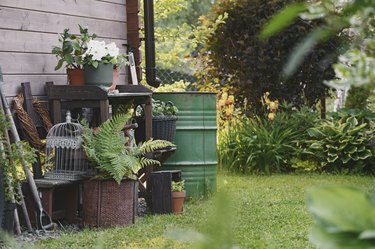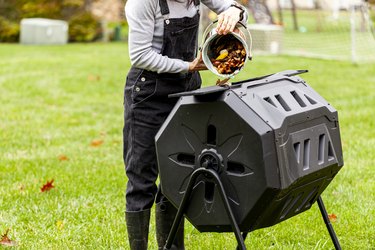
If you want to limit food and plant waste in your home, as well as reduce the need for a chemical fertilizer for your plants, an outdoor compost bin can help tremendously. A compost bin is a container that you put organic waste into so it can compost over time. Compost consists of plant and food waste that is decomposed and recycled. All home composting requires three basic ingredients: Browns, which include dead leaves, branches and twigs; greens, which are grass clippings, fruit and vegetable waste and coffee grounds; and water. Compost is rich in plant nutrients and helpful organisms like worms and fungal mycelium, and it's used to fertilize and improve the soil.
Through the right combination of moisture and air, the ideal conditions inside a compost bin are produced for aerobic organisms to turn the organic materials into compost quicker than if the waste was in a compost pile outside of a bin. Some compost bins are continuous, which allows you to keep adding food scraps and other waste to them over time, while others require you to add all the ingredients at one time to create the mixture right then.
Video of the Day
Video of the Day
Composting doesn't have to happen outdoors, but you can generally fit way more waste into an outdoor compost bin than a kitchen compost bin. If you do prefer an indoor compost bin, we put together a list of some really great electronic composters that can be conveniently placed on the kitchen counter without the worry of odors or attracting wild animals.
What to Consider When Purchasing an Outdoor Compost Bin
Type: There are several different types of outdoor compost bins that have different pros and cons:
- Compost Bin: If you have the space for it and a lot to compost, a stationary compost bin is a good option as it's affordable and low-maintenance. They can typically hold between 75 and 200 gallons of waste, and they're generally larger than tumblers. You can add food waste and other organic materials consistently, and composting time will take several months or longer to finish, depending on how hot it is outside.
- Compost Tumbler: Best for fast composition, a tumbler is a barrel that can be rolled or tumbled for aeration, giving microorganisms plenty of oxygen to help them compost quickly. Tumblers are often on wheels for easy portability. A dual-chamber compost tumbler allows you to process two separate batches at the same time by adding compost ingredients to one side while waiting for the other side to cure. Side note: If you have a rat problem in your area, you might want to consider a tumbler since there's no way any animals can get inside when the lid is closed and locked.
- Worm Composter: Worm composting is the process of using red wiggler worms to recycle fruit and vegetable scraps and other organic material into a soil called vermicompost, or worm compost. The worms eat the organic waste and their droppings create a rich soil conditioner for plants. A worm composter can be used outdoors or indoors.
- Anaerobic Versus Aerobic: Aerobic composting is the decomposition of organic matter using microorganisms that need atmospheric oxygen to thrive. For the compost bin to properly "breathe," the right mixture of ingredients needs to be applied (kitchen scraps, yard waste and water) before occasionally turning the pile to avoid compaction. A way to know that a composting system is aerobic is to stick your hand inside. If the bin feels hot, it means the aerobic organisms are present and doing their job by "cooking" the waste. Aerobic compost bins are the most common, but some people prefer anaerobic. Anaerobic pertains to organisms that can live without atmospheric oxygen, like bacteria. Anaerobic compost bins don't need to be frequently turned since instead of heating up the waste, the goal is for fermentation to take place. The bonus is that it's less labor-intensive, but anaerobic bins do produce a nasty smell.
Material: The most common compost bins are made of plastic or metal. Plastic composters are affordable and weather-resistant and many are made from recycled materials, but they tend to wear down and eventually crack from sun damage and other outdoor elements. Stainless steel composters are less common and heavier, but they are more durable, longer-lasting and offer a modern aesthetic.
Now that you know a bit more about composting, check out our top picks for the best compost bins and tumblers of 2022.
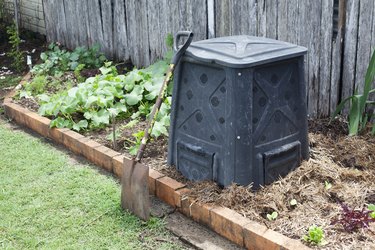
The Best Overall Composter
If you live by a "less mess is best" philosophy, you're going to enjoy the FCMP Outdoor Dual Chamber Tumbling Composter. It's an easy and efficient tumbler, making it a great option for beginners and experts alike. Two separate chambers allow the one side to finish while leaving the other side available for fresh waste. Once you have finished compost, continuously swapping sides will create an uninterrupted flow of rich, healthy compost. You only need to turn the tumbler every two to three days, and in the right conditions and with the right ingredients, the compost can be ready in as little as two weeks.
At a Glance:
- Dimensions: 28" x 30" x 36" (LxWxH)
- Capacity: 37 gal.
- Material: Partially recycled plastic
- Special Features: Dual chamber, recycled materials, BPA-free
The Best Budget Composter
Another great option from FCMP Outdoor is this affordable tumbler composter, ideal for small backyards and those new to composting. Made of recycled, UV-inhibited and BPA-free polyethylene plastic, this tumbler can hold 19 gallons of kitchen waste and yard scraps. The tumbler needs to be turned five to six times every two to three days to break down the contents, but you won't have to use a pitchfork. Ergonomic handles make this rolling composter easy to move around your outdoor space as needed.
At a Glance:
- Dimensions: 24'' x 12'' x 24''
- Capacity: 19 gal.
- Material: Recycled plastic
- Special Features: Portable
The Best Worm Composter
The VermiHut Worm Compost Bin turns food scraps and shredded paper into nutrient-rich vermicompost. While this worm farm isn't the most aesthetically pleasing worm compost bin, it's a no nonsense system that gets the job done. Five trays allow you replace a tray when it's full of food and casting, plus you can purchase additional trays for even more composting. The plastic bin features a water spigot to help maintain a proper water level, and a worm saver board ensures that no worms drown in the excess water around the spigot. To help reduce any odors, you can add a coconut coir filter to the top of the bin for more airflow. A set of ant-trappers are included with the unit to prevent ants from invading.
At a Glance:
- Dimensions: 17" x 17" x 33"
- Capacity: 10 lbs. worms, 5 lbs. food scraps
- Material: Plastic
- Special features: Ant-trapper, spigot
The Best Compact Composter
If you have a small yard, balcony, patio or porch, the Miracle-Gro Small Composter is a great option, as it's compact enough to fit an outdoor space of any size. This tumbler will turn your kitchen and garden waste into rich, fertile compost in just four to six weeks. The plastic is BPA-free, food-grade and UV-protected, which means you don't have to worry about toxins seeping into your compost. Tightly locking sliding doors keep the pests out, too.
At a Glance:
- Dimensions: 24.13" x 21.5" x 4.33"
- Capacity: 27.7 gal.
- Material: Recycled plastic
- Special Features: Two-year warranty
The Best Dual-Chamber Composter
This is the dual-chamber version of the Miracle-Gro Small Composter listed above. You can cure compost in one chamber while you add kitchen and garden scraps to the other for a consistent supply of ready-to-use compost. To use, load the ingredients into one side, close the sliding door and use the handle to turn it every few days. The heavy-duty tumbler is durable and can be used for year-round composting. Each chamber holds 18.5 gallons for a total of 37 gallons of waste.
At a Glance:
- Dimensions: 25.6" x 32.3" x 23.6"
- Capacity: 37 gal.
- Material: Recycled plastic
- Special Features: Gardening gloves included
